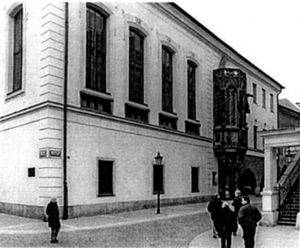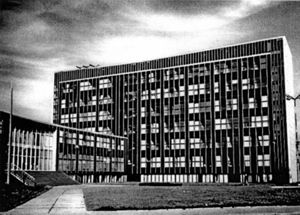
Chemistry International
Vol. 20 (1998)
1998, Vol. 20
No.
1 (January)
No.
2 (March)
No. 3 (May)
No. 4 (July)
No. 5 (September)
No. 6 (November)
Index to 1998 CI
Chemistry International
1998, Vol. 20, No. 3 (May)History of chemistry in the Czech Republic
Chemistry International inaugerates in this issue a new series of articles describing the history and status of Chemistry in the member countries of the Union.Our first article describes the History and Current Status of Chemistry in the Czech Republic
What is now the Czech Republic is in an area that was occupied by the West-Slav Czech tribes (Samo Empire, AD 623-658). The Premyslides dynasty originated among these tribes. The beginnings of the Czech state extend back to the period of the reign of the first Czech Prince Borivoj at the castle site Budec in the Prague Basin (by 891). The nucleus of the Czech state was fixed during the reign of Prince Wenceslas (924-935). The Premyslides of the House of Slavnik were able to centralize the whole territory of Bohemia in the 10th century. Beginning in the first half of the 11th century, further regions were annexed, and during the 13th century, the basis of the feudal political formation was created as the Counties of the Czech Crown.
The Czech King and Holy Roman Emperor Charles IV of the House Luxembourg (1316-1372), made the royal seat Praha the largest town of Central Europe and founded the oldest university in Central Europe. Many outstanding scholars were affiliated with the Charles University. The great progress of natural philosophy in the Czech Kingdom occurred during the second half of the 16th century when Rudolph II (1552-1612), who was both Czech King and Holy Roman Emperor (1576-1611), supported alchemy, astrology and arts, as well as inviting many learned men to work at court, e.g. the astronomers Tycho de Brahe and Johannes Kepler (from 1600 to 1611). One of the great men in the history of Czech civilization was Jan Amos Komensky (1592—1670), who created the fundamentals of modern pedagogy and who occupies a prominent position in the world history of teaching for his work in methods of cognition and knowledge.
A change-over from hand manufacture to machine production was in progress in Bohemia during the 18th century when the pre-scientific stage of chemistry (iatro-chemistry, pflogiston theory) was transformed step by step into science. In 1707, the Professional School of Engineering was opened in Praha; this School became, in 1803, the Polytechnic Institute from which the Czech Technical School in Praha arose in 1863 (the Czech Technical University at Praha from 1920 onwards). Another school, the Private School of the Arts, Humanities and Social Sciences was active in the period 1770-1775 and, in 1784, changed its title to the Czech Society of Science. This Society was then, in 1790, renamed the Royal Czech Learned Society which, as the only Czech learned society, published the results of Czech scientific research into the 19th century. In 1871, the Czech Chemical Society was established, the Society for Chemical Industry followed in 1892; lastly, the two Societies merged into the Czech Society for Science and Industry (1906). The Czech Academy of Science and Art was founded in 1890 (originally the Czech Academy of Emperor Francis Joseph).
In 1895, the Czech Technical Foundation, an association of Czech engineers, was established in Praha with the aim of issuing technical literature in the Czech language and supporting its formation. (For the development of industry in the 18th and 19th centuries, see below.)
The Czech contributions to the development of chemistry were, from the first half of 19th century to the first half of the 20th century, made predominantly in universities. There, research was carried out in departments chaired by outstanding Czech professors of chemistry. Some notable examples are: Bohuslav Brauner (1855-1935), a disciple of R.W. Bunsen and H.E. Roscoe and Mendeleev’s friend. Brauner was a pioneer of the periodic system of elements. He determined the atomic weights of 26 elements, including the lanthanides La, Ce, Pr, Nd and Sm and the actinides Th and U. He also proposed oxygen as the basis of relative atomic weights (1888). Emil Votocek (1872-1950), founding father of the Czech scientific school of organic chemistry, was the author of many original studies in the field of the chemistry of saccharides.
Votocek´s successor was Rudolf Lukes (1897-1960) who was in scientific contact with L. Ruzicka (1887-1976, Nobel Prize in 1939, honorary doctor’s degree from Charles University in 1948) and V. Prelog (1906-1998, a graduate of the Czech Technical University at Praha, Nobel Prize in 1975), professors at the technical college in Zurich. Jaroslav Heyrovsky (1890-1967) discovered the use of a dropping mercury electrode for electrolysis (1922). He was awarded the Nobel Prize for discovering the polarographic method and its use in analytical chemistry (1959). Frantisek Sorm (1913-1980), headed a research group that became famous for the synthesis of natural compounds, mainly terpenes and biologically active components of plants. Otto Wichterle (*1913), the author of excellent textbooks of inorganic and organic chemistry and inventor of the soft contact lens; his research group discovered rapid casting polymerization of lactams. There were 22 schools of the university type in Czechoslovakia in 1949, 36 schools in 1982, and 41 schools in 1987. In the Czech Republic, there were 18 of those schools in 1991 out of which six schools either were specialized in the education of chemistry or included faculties for teaching in chemistry–Charles University (Praha), Masaryk University (Brno), Palacky University (Olomouc), Institute of Chemical Technology at Prague, University Pardubice (Pardubice), and Technical University Brno (Brno). In 1952, the Czechoslovak Academy of Sciences was established (the Academy of Sciences of the Czech Republic at present), and the centre of fundamental research in all branches of science was shifted to its scientific institutes (totalling 64), among them are the Institute of Inorganic Chemistry (Praha), Jaroslav Heyrovsky Institute of Physical Chemistry (Praha), Institute of Organic Chemistry and Biochemistry (Praha), Institute of Macromolecular Chemistry (Praha), Institute of Analytical Chemistry (Brno), and Institute of Chemical Process Fundamentals (Praha). All the laboratories of the Academy were equipped with the most modern instruments, and their research results, published in scientific periodicals or delivered as lectures at international meetings, have been recognized worldwide, e.g. the studies of R. Zahradník in the field of quantum chemistry, and the papers of A. Holy on the syntheses of nucleic acids and on the chemistry of antimetabolites.
An early symptom of the industrial revolution in Bohemia was the Industrial Exposition arranged in Praha in 1791 as the first of that type in Europe. The first chemical plant had been put into operation in Lukavec as early as 1630. During the following two hundred years, it produced sulfur bloom and rolls, Czech sulfuric acid (vitriol, oleum), vitriol of copper, vitriol of iron, ochre of iron, muriatic acid, nitric acid, and English sulfuric acid (chamber acid). From 1800, there were Starck Works in Bohemia (Kraslice, Hromnice, Vranov, Kazncjov), which produced, in addition to the chemicals produced by Lukavec, alum, Glauber’s salt, and citric acid. In 1801, the first sugar-beet factory was opened in Bohemia (Horovice). The first establishment for chemical production in Praha (muriatic acid, nitric acid, Glauber salt) dates from 1815. The production of soda by the Leblanc process existed in Hrusov (1851). In 1856-57, two significant chemical concerns were founded in Bohemia– the Chemical Factory Carl Rademacher & Co. (Praha–Karlín) and, the Syndicate for Chemical and Metallurgical Production (Ústí nad Labem). During the latter part of the 19th century and the first part of the 20th century, many chemical works arose, e.g. of dynamite (Roztoky u Prahy, 1868), ammonia and ammonium salts (Praha–Zizkov, 1869), fertilizers and chemicals (Kolín, 1871), lacquers and tin salt (Praha, 1894), zinc paints (Retenice, 1895), carbide (Libkovice, 1899), and paints (Letovice, 1910).
After the First World War, industry formed the main part of the national product in Czechoslovakia; its industrial production was the seventh highest in the world. After a stagnation during the Second World War, through 1982, production advanced roughly 13-fold on average. Some examples of production increases in specific products (in thousands tons) are, from 1937 through 1982: plastics 1/957, synthetic fibres 4/180, paper 246/928, refined sugar 667/894, and cement 1273/10 325.
In the Czech Republic (area ª 79 000 km2 , population = 10 000 000), 41% of the population was active in industry. This was 66.7% of the national income in 1983. In 1991, there were 223 industrial works, among them 31 works for the production of chemical and rubber materials (e.g. Barum—Otrokovice, Kaucuk—Kralupy nad Vlt., Chemical Works—Sokolov, Chemopetrol—Litvínov, Fatra—Napajedla, Gumotex—Breclav, Lachema—Brno, Moravian Chemical Works—Ostrava, North-Czech Chemical Works—Lovosice, Optimit—Odry, Silon—Planá nad Luz, Spolana Neratovice, Synthesia—Semtín, Technoplast—Chropync). In addition, the Ministry of Health coordinated 10 production establishments (e.g. Galena—Komárov u Opavy, Research Institute of Antibiotics and Biotransformations—Roztoky u Prahy, and Research Institute of Pharmacy and Biochemistry—Praha). The economic results of chemistry was affected also by the activity of the institutes of applied research (16, e.g. Research Institute of Inorganic Chemistry—Ústí nad Labem, Research Institute of Organic Syntheses—Rybitví, and Institute for Research, Production and Application of Radio-isotopes—Praha) and design institutions (23, e.g., Chemoprojekt—Praha). All those works and establishments turned into joint-stock companies after the split of the Czech and Slovak Federal Republic and the formation of the Czech Republic at the beginning of 1993. The chemical turnover for the Czech Republic in 1993 was 2.47 x 109 USD (according to CEFIC figures).
Czechoslovakia has been a member of the International Union of Pure and Applied Chemistry (IUPAC) since 1920, shortly after its foundation. The representatives of Czechoslovakia have always been significant participants in Union activity. Some of the well known Czech personalities were members of Bureau of IUPAC: E Votocek (Vice-President of IUPAC, 1922—1925), O. Tomicek (1947—1951), O. Wichterle (1961— 1971, Member of the Executive Committee 1965—1969, one of founders and the first President of the Macromolecular Division, 1967—1971), V. Herout (1969—1977), and A. Vlcek (1979—1987, Member of the Executive Committee 1985—1987). Out of many other active Czech members of IUPAC we should also mention B. Brauner, who was a founder-member and later the Chairman of the IUPAC Commission on Chemical Elements (1921), and P. Kratochvíl who was the Chairman of the Commission on Macromolecular Nomenclature for six years (1985—1991). At the present time, the Czech Republic is represented by the Czech National Committee for Chemistry as well as by 10 elected members and 15 nominated national representatives on IUPAC Standing Committees and Division bodies. There are a number of institutions in the Czech Republic (e.g. the Czech Commission on Nomeclature of Organic Chemistry, the Czech Commission on Macromolecular Nomenclature, and J.M. Marci Spectroscopic Society) that translate IUPAC documents and publish them in the national chemical journal Chemické Listy, as well as the National Centre of IUPAC for the Czech Republic that distributes IUPAC documents on nomenclature and terminology (in English and Czech). The IUPAC General Assembly and the IUPAC Congress were held in Prague in 1967; since that year, 55 meetings in the series of Prague Meetings on Macromolecules (Microsymposia and Discussion Conferences on Macromolecules, under the auspices of IUPAC) have been organized in Prague. The IUPAC International Symposia on Macromolecules were held in Prague in 1957, 1965 and 1992.
P. Cefelín,
Associate Member of the Macromolecular Division
Committee of IUPAC and Secretary of the Czech
National Committee for Chemistry
News
and Notices - Organizations and People
- Standing Committees
Divisions
- Projects - Reports
- Publications - Symposia
- AMP - Links
Page last modified 23 August 2000.
Copyright © 1997-2000 International Union of Pure and Applied Chemistry.
Questions or comments about IUPAC, please
contact the Secretariat.
Questions regarding the website, please contact [email protected]


